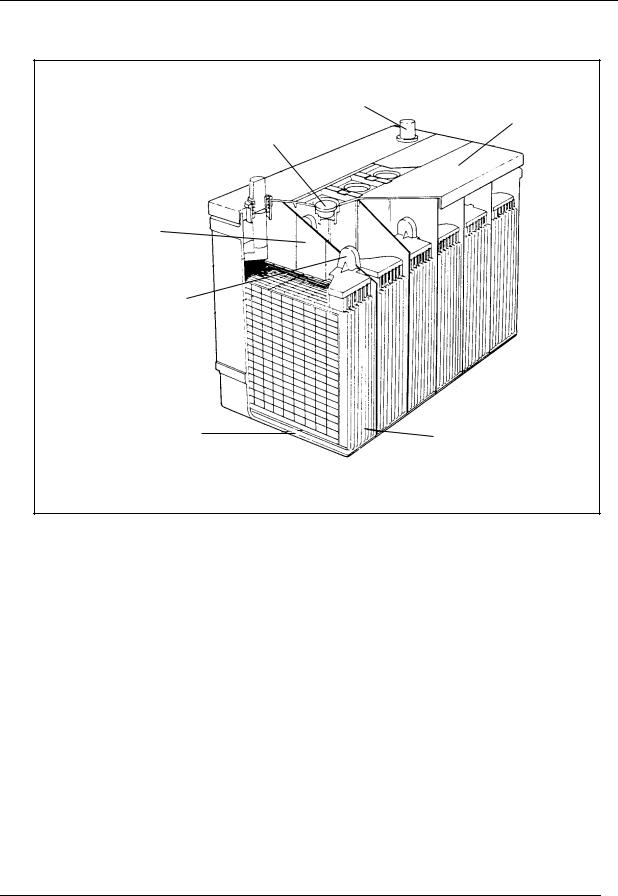
- •FOREWORD
- •OVERVIEW
- •TABLE OF CONTENTS
- •LIST OF FIGURES
- •LIST OF TABLES
- •INTRODUCTION
- •DEFINITIONS
- •BATTERY COMPONENTS AND OPERATION
- •Cells vs. Batteries
- •Primary and Secondary Cells and Batteries
- •Battery Components
- •Cell and Battery Voltage
- •Capacity and Battery Ratings
- •Series and Parallel Connections
- •LEAD-ACID BATTERY TYPES
- •Flooded Lead-Acid Batteries
- •Sealed Lead-Acid Batteries
- •OPERATION AND CONSTRUCTION
- •Lead-Acid Battery Active Materials
- •Electrochemistry of the Lead-Acid Cell
- •Negative and Positive Plate Construction Methods
- •Antimony/Calcium/Selenium/Tin Alloying
- •Specific Gravity
- •Effects of Discharge Rate and Temperature on Capacity and Life
- •APPLICATIONS
- •Starting, Lighting, and Ignition
- •Industrial
- •Traction
- •Stationary
- •Portable
- •SIZING AND SELECTION
- •MAINTENANCE
- •General
- •Matching the Charger to Battery Requirements
- •Avoiding Overdischarge
- •Maintaining Electrolyte Levels
- •Cleaning
- •Avoiding High Temperatures
- •Supplying an Equalizing Charge
- •Safety Precautions
- •Testing
- •STORAGE, TRANSPORTATION, AND DISPOSAL
- •Storage
- •Transportation
- •Disposal
- •BIBLIOGRAPHY
- •CONCLUDING MATERIAL

Lead-Acid Storage Batteries |
DOE-HDBK-1084-95 |
APPLICATIONS |
|
|
|
APPLICATIONS
There are numerous applications for the use of lead-acid storage batteries. They range from the extremely large battery systems used in load leveling by electrical utility companies to the relatively small batteries used in hand tools. Batteries may need to undergo deep and frequent cycling such as those used for electric vehicle power or they may remain on "float" as in an emergency lighting application and only rarely be discharged. Clearly, these applications cannot all use the same battery. Restraints on parameters such as operating temperature, desired capacity, voltage and power requirements, etc., affect the type of battery chosen.
All the above considerations are taken into account by determining the battery'sduty cycle. The duty cycle is the required operating parameters of a cell or battery including factors such as charge and discharge rates, depth of discharge, cycle length, and length of time in the standby mode. The duty cycle must be known and included in the battery procurement specification. The duty cycle and battery chosen will also determine the type of charger used. More details on matching chargers to batteries and applications are included in later paragraphs. More information on duty cycles is included in the section entitled "Sizing and Selection."
The major categories of lead-acid battery applications are starting, lighting, and ignition (SLI); industrial, including traction and stationary applications; and small portable equipment. A brief description of each type is included below along with example uses of each type.
Starting, Lighting, and Ignition
SLI batteries are used by most people every day and are produced in greater numbers than any other type of lead-acid storage battery. These are used to start automobiles and most other kinds of internal combustion engines. They are not suitable for deep discharge applications, but excel for uses needing a high current for a brief time. They are usually charged in a "partial float" manner, meaning that the battery only receives a float charge while the vehicle is running. A cutaway view of a typical SLI battery is shown in Figure 12. SLI batteries are usually of the flat pasted plate design.
Industrial
Industrial batteries generally have the largest capacity of the three major categories of leadacid batteries. Industrial batteries are used for vehicle traction and stationary applications.
Traction
Traction batteries are used to provide motive power for electric or hybrid vehicles. The major emphasis on traction battery design is the necessity of a high capacity to weight
Rev. 0 |
Page 23 |
Batteries |

APPLICATIONS |
DOE-HDBK-1084-95 |
Lead-Acid Storage Batteries |
|
|
|
Standard terminals |
Heat sealed |
Triple-baffle gas trapping and |
construction |
|
|
venting system conserves liquid |
|
Larger electrolyte reservoir
Through-partition intercell connectors
Plates embedded in epoxy
to resist vibration failure
Plate envelope prevents bottom shorting
Figure 12. Cutaway view of a typical battery used for starting, lighting, and ignition (SLI).
and volume ratio, since the vehicle must also carry its power source. Traction batteries are frequently deep cycled and require a fast charging rate for use usually within
24 hours. Typical applications are motive power for fork lifts and electric carts. Traction batteries are usually of the tubular plate design, which performs more favorably during deep cycle operation.
Stationary
Stationary batteries come in a wide variety of designs for different applications. They are used for applications where power is necessary only on a standby or emergency basis. Stationary batteries are infrequently discharged. Stationary batteries remain on a continuous float charge so that they can be used on demand. The largest types of stationary batteries are those used for electrical load leveling. Load-leveling batteries store electrical energy for times of peak power demand and are taken off-line during
Batteries |
Page 24 |
Rev. 0 |
